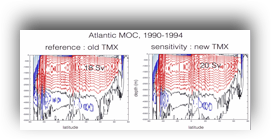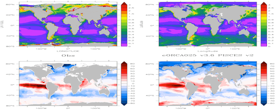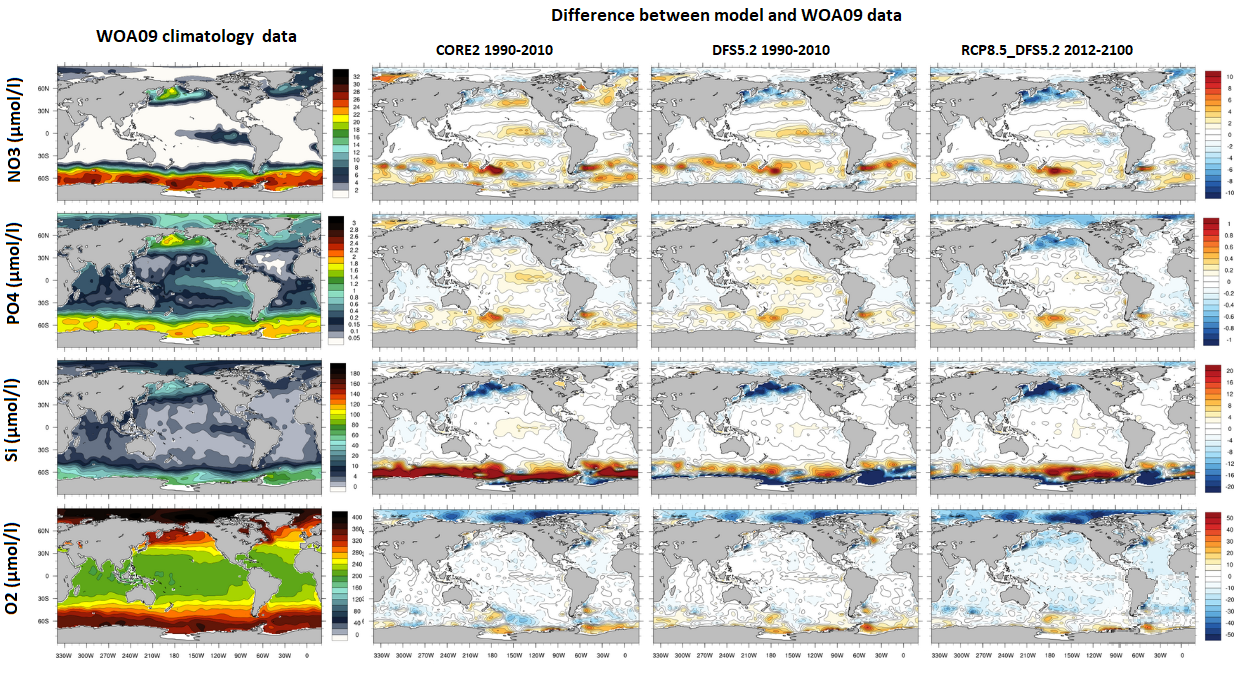WP2 : Global model integration and run production
Task 2.1 Preparation of the physical configuration
During SOBUMS, development of the circulation component of NEMO (OPA), i.e., without biogeochemistry (PISCES), was initiated in 2016, a collaboration between IPSL in Paris and the LGGE MEOM in Grenoble. The initial strategy was to start from an ORCA025 configuration developed within the DRAKKAR consortium, to increase the vertical resolution near the surface, to extend the grid to include under-ice regions in certain shelf seas, and to test new model parameterizations.
Thus during this upgrade to the eORCA025 configuration, the NEMO ocean model has been updated to its most recent version, which includes the newly tested tide-induced mixing parameterization and freshwater distribution within the water column. In addition, much effort has been devoted to adjust model parameters in order to reduce the small-scale effects and improve ventilation in the deep ocean (Fig. 1).

Task 2.2 Integration of the biogeochemical component eORCA025-NEMO-PISCES
After developing and validating the physical component of NEMO, we adjusted the marine biogeochemistry component PISCES to optimize physical-biogeochemical coupling on the eORCA025 grid. Adjustments included optimizing the biogeochemical models parameters and boundary conditions and making technical modifications to optimize computational resources.
With that new NEMO-PISCES configuration on the eORCA025 grid, we then made our first reference simulations, forcing them with interannually varying fluxes from an atmospheric reanalysis (CORE II) over 1948-2009. Preliminary results suggest that generally the model satisfactorily simulates large-scale patterns of key biogeochemical tracers and fluxes, e.g. surface chlorophyll and sea-to-air CO2 fluxes (Figure 2).

Fig. 2 : Annual mean of observed (left) and simulated (right) fields for surface chlorophyll (top) and the sea-to-air CO2 flux (bottom).
Task 2.3 Production of reference and sensitivity experiments to changing stressor
For our first productions simulations, before engaging the immense computational resources needed to make simulations with the high-resolution eORCA025 configuration, with have made production simulations with the lower resolution configuration ORCA2 of the NEMO-PISCES model.
To test the effect of the atmospheric forcing, we made identical NEMOPISCES simulations over the same 20-year period (1990-2009), which differed only in terms of the atmospheric reanalysis used for the forcing. One simulation was made with the CORE2 forcing and another was made with the DFS5.2 forcing. Figure 3 reveals that relative to CORE2, the DFS5.2 forcing generally leads to smaller residuals between simulated and observed climatological annual-mean fields for dissolved oxygen and nutrients (WOA09).
In addition, one simulation was made to begin to assess potential future changes. In that 'future' simulations, the ORCA2 configuration of the NEMO-PISCES model was forced with the DFS5.2 atmospheric reanalysis, repeating its 1958-2012 loop until year 2100, while adding in atmospheric forcing anomalies from a former CMIP5 simulation of the IPSL-CM5 earth system model under the RCP8.5 scenario (DeltaClim, need reference here). A preliminary analysis indicates that during the next 100 years under the RCP8.5 forcing, there are large simulated changes in biogeochemical variables in the Southern Ocean and the North Pacific.

Fig. 3 : Annual means of surface nitrate, total dissolved inorganic phosphorus, total dissolved silicon, and dissolved oxygen: observations (WOA09) (column 1), CORE2-WOA09 and DFS5.2-WOA09 as averages over 1990-2009 (columns 2-3), and RCP8.5-DFS5.2 over 2012-2100.